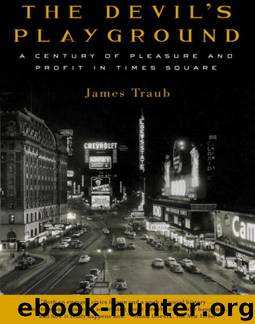The Devil's Playground: A Century of Pleasure and Profit in Times Square by James Traub

Author:James Traub
Language: eng
Format: mobi, epub
Tags: History
ISBN: 0375759786
Publisher: Random House
Published: 2004-01-02T00:00:00+00:00
11.
SAVING BILLBOARD HELL
THE REDEVELOPMENT OF 42nd STREET, whatever its flaws, was an act of urban planning, a conscious re-creation of a bounded urban space almost from the ground up; but the rest of Times Square, seedy but not pathological, was for many years permitted to develop, or not, according to the fluctuations of the marketplace. No large structure had gone up along the great spillways of Broadway and Seventh Avenue since the 1930s. But the real estate boom of the sixties, which had filled the East Side of midtown Manhattan with big buildings, had made the West Side, with its traditionally low scale, look increasingly appealing as a development site. In 1966, the Astor Hotel, a remnant of Times Square’s age of opulence that occupied the block immediately to the north of the Paramount, was closed, and then demolished, to make way for a fifty-four-story building to be designated 1 Astor Plaza, a fabricated address designed to link a new and thoroughly unloved building to the past represented by the building it had replaced. But 1515 Broadway, as the building was universally known, remained a solitary, and largely empty, foray into Times Square for many years.
A developer named Peter Sharp had been patiently assembling parcels on the block immediately to the north of the Astor throughout the 1960s. By 1970, Sharp was ready to commission a design. He turned to Robert Venturi, the provocative architect who wrote Complexity and Contradiction in Architecture. Venturi proposed something radically different from 1 Astor Plaza: rather than replace the hodgepodge of buildings with a tower, he proposed to wrap the entire assemblage in huge signs. Venturi described his thinking in a subsequent book, Learning from Las Vegas (written with Steven Izenour and Denise Scott Brown). “Times Square is not dramatic space,” he wrote, “but dramatic decoration. It is two-dimensional, decorated by symbols, lights and movement.” Thus he concluded that “a decorated shed” would be a more apt homage to its traditions than “megastructural bridges, balconies and spaces.” Venturi was the first architect to propose a new idiom faithful to Times Square’s helter-skelter, mongrelized past; but since he had done so with an almost perverse indifference to the site’s economic value, the developer rejected the idea.
Sharp was, on the other hand, dazzled by the work of John Portman, the architect-developer who had built the Peachtree Center in Atlanta, and who was becoming known for his glass hotels with soaring interior spaces. Portman was one of the iconic figures of the age of urban renewal, for he built immense structures which spanned, or simply abolished, the traditional street grid; many of them turned a great, blank concrete wall to the street. Portman was a very busy man; he was then working on the Renaissance Center, in Detroit, and Embarcadero Center, in San Francisco. He proposed to build a two-thousand-room hotel where Venturi had hoped to raise a decorated shed. The plan envisioned two great concrete slabs rising fifty-six stories connected by five-story-high bridges like the rungs of a great ladder.
Download
The Devil's Playground: A Century of Pleasure and Profit in Times Square by James Traub.epub
This site does not store any files on its server. We only index and link to content provided by other sites. Please contact the content providers to delete copyright contents if any and email us, we'll remove relevant links or contents immediately.
| Africa | Americas |
| Arctic & Antarctica | Asia |
| Australia & Oceania | Europe |
| Middle East | Russia |
| United States | World |
| Ancient Civilizations | Military |
| Historical Study & Educational Resources |
The Body: A Guide for Occupants by Bill Bryson(4974)
Liar's Poker by Michael Lewis(3367)
Into Thin Air by Jon Krakauer(3308)
Tuesdays With Morrie by Mitch Albom(2688)
Into the Wild by Jon Krakauer(2581)
The Diamond Cutter by Geshe Michael Roach(2017)
My Dark Places by James Ellroy(1876)
Columbine by Dave Cullen(1813)
Helter Skelter: The True Story of the Manson Murders by Vincent Bugliosi & Curt Gentry(1697)
Extraordinary, Ordinary People by Condoleezza Rice(1468)
Everything in Its Place by Oliver Sacks(1442)
Pilgrim at Tinker Creek by Annie Dillard(1390)
Into the wild by Jon Krakauer(1380)
You Can't Touch My Hair by Phoebe Robinson(1356)
The Girls: Sappho Goes to Hollywood by Diana McLellan(1281)
Dark Towers by David Enrich(1204)
Betrayal by Gregg Olsen(1201)
Call Sign Chaos by Jim Mattis & Bing West(1183)
The Letters of Allen Ginsberg by Allen Ginsberg(1112)
